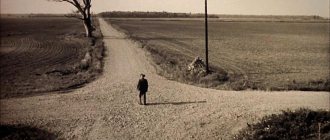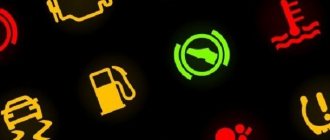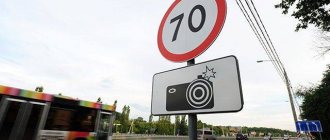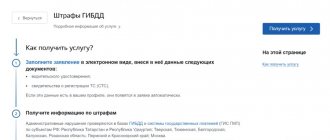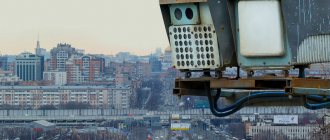Visual traffic control symbols may be installed for a limited period. They differ from stationary ones in appearance, but sometimes drivers confuse the temporary sign with the permanent one located on the yellow-green board. In addition, many are confident that they will not face anything for ignoring the requirements of the current limited-term symbol.
Read about what temporary road signs are, where and how they are installed, as well as the rules they dictate.
Temporary road signs in traffic regulations and their features
The traffic rules stipulate that the following symbols can be valid for a limited period:
- 1.8, notifying that traffic is regulated by a traffic light;
- 1.15, installed on slippery surfaces;
- 1.16, informing about uneven roads;
- 1.18, warning about the release of gravel under the wheels of the car;
- 1.20.1-1.20.3, installed before the narrowing of the web;
- 1.21, notifying about the establishment of two-way traffic;
- 1.25, informing about road works;
- 1.32, indicating that there is a traffic jam on the way;
- 1.33, warning of danger;
- 1.34.1, 1.34.2, indicating the direction of rotation;
- 2.5, prohibiting driving without stopping;
- 2.6, determining the advantage of oncoming traffic;
- 2.7, limiting the scope of the previous pointer;
- 3.20, prohibiting overtaking in the area;
- 3.21, terminating 3.20;
- 3.24, limiting the maximum permitted speed;
- 3.25, completing the zone of influence of the previous symbol;
- 4.2.1-4.2.3, indicating the need to go around an obstacle;
- 6.17, showing the detour scheme;
- 6.18.1-6.18.3, showing the direction in which to avoid the obstacle;
- 6.19.1, 6.19.2, establishing the need to change lanes to another carriageway when the first one is closed to traffic.
But taking into account specific conditions, any designation can be established for a limited period.
According to traffic regulations, temporary road signs are often combined with each other and supplemented with signs that clarify the territory of their influence or indicate the distance to the problem area. Some of them are rare. Others can be seen in populated areas as well as on highways.
We recommend reading about what traffic markings are like on the road. From the article you will learn about the types of markings according to traffic regulations, what markings mean depending on color and application, what to do if the markings are not visible on the road. And here is more information about how to follow the “Main Road” road sign.
Temporary signs
1.8 Traffic light regulation (temporary)
1.8 Traffic light regulation (temporary)
- Price: 0 rub.
Size:
Film type:
- Buy
- Read more..
1.15 Slippery Road (temporary)
1.15 Slippery Road (temporary)
- Price: 0 rub.
Size:
Film type:
- Buy
- Read more..
1.16 Rough Road (temporary)
1.16 Rough Road (temporary)
- Price: 0 rub.
Size:
Film type:
- Buy
- Read more..
1.18 Gravel release (temporary)
1.18 Gravel release (temporary)
- Price: 0 rub.
Size:
Film type:
- Buy
- Read more..
1.19 Dangerous shoulder (temporary)
1.19 Dangerous shoulder (temporary)
- Price: 0 rub.
Size:
Film type:
- Buy
- Read more..
1.20.1 Road narrowing (temporary)
1.20.1 Road narrowing (temporary)
- Price: 0 rub.
Size:
Film type:
- Buy
- Read more..
1.20.2 Road narrowing (temporary)
1.20.2 Road narrowing (temporary)
- Price: 0 rub.
Size:
Film type:
- Buy
- Read more..
1.20.3 Road narrowing (temporary)
1.20.3 Road narrowing (temporary)
- Price: 0 rub.
Size:
Film type:
- Buy
- Read more..
1.21 Two-way traffic (temporary)
1.21 Two-way traffic (temporary)
- Price: 0 rub.
Size:
Film type:
- Buy
- Read more..
1.25 Road works (temporary)
1.25 Road works (temporary)
- Price: 0 rub.
Size:
Film type:
- Buy
- Read more..
1.33 Other hazards (temporary)
1.33 Other hazards (temporary)
- Price: 0 rub.
Size:
Film type:
- Buy
- Read more..
2.6 Right of way for oncoming traffic (temporary)
2.6 Right of way for oncoming traffic (temporary)
- Price: 0 rub.
Size:
Film type:
- Buy
- Read more..
3.11 Weight limitation (temporary)
3.11 Weight limitation (temporary)
- Price: 0 rub.
Size:
Film type:
- Buy
- Read more..
3.12 Limitation of weight per vehicle axle (temporary)
3.12 Limitation of weight per vehicle axle (temporary)
- Price: 0 rub.
Size:
Film type:
- Buy
- Read more..
3.13 Height limitation (temporary)
3.13 Height limitation (temporary)
- Price: 0 rub.
Size:
Film type:
- Buy
- Read more..
3.14 Width limitation (temporary)
3.14 Width limitation (temporary)
- Price: 0 rub.
Size:
Film type:
- Buy
- Read more..
3.15 Length limitation (temporary)
3.15 Length limitation (temporary)
- Price: 0 rub.
Size:
Film type:
- Buy
- Read more..
3.16 Minimum distance limitation (temporary)
3.16 Minimum distance limitation (temporary)
- Price: 0 rub.
Size:
Film type:
- Buy
- Read more..
3.18.1 Turning right is prohibited (temporary)
3.18.1 Turning right is prohibited (temporary)
- Price: 0 rub.
Size:
Film type:
- Buy
- Read more..
3.18.2 Left turn prohibited (temporary)
3.18.2 Left turn prohibited (temporary)
- Price: 0 rub.
Size:
Film type:
- Buy
- Read more..
3.19 U-turn prohibited (temporary)
3.19 U-turn prohibited (temporary)
- Price: 0 rub.
Size:
Film type:
- Buy
- Read more..
3.20 Overtaking is prohibited (temporary)
3.20 Overtaking is prohibited (temporary)
- Price: 0 rub.
Size:
Film type:
- Buy
- Read more..
3.21 End of no-overtaking zone (temporary)
3.21 End of no-overtaking zone (temporary)
- Price: 0 rub.
Size:
Film type:
- Buy
- Read more..
3.22 Overtaking by trucks is prohibited (temporary)
3.22 Overtaking by trucks is prohibited (temporary)
- Price: 0 rub.
Size:
Film type:
- Buy
- Read more..
- 1
- Forward
- In the end
In areas where repair and restoration work is being carried out, as well as during construction near roads, according to amendments to GOST 52290-2004, it is necessary to use temporary road signs on a yellow background. Temporary road signs differ from permanent ones in that they have a yellow background. Temporary road signs are installed in accordance with the schemes for organizing the movement of vehicles and pedestrians at the work site. Schemes for organizing traffic and fencing work sites for the installation of structures must be approved by the head of the organization and agreed in advance with the authorities of the State Road Safety Inspectorate (STSI). The dimensions of temporary road signs must be no less than those that should be used for a given category of road or street in accordance with the current standard. When carrying out work on highways, as well as when justifying the feasibility - on dangerous sections of other roads, signs of an increased standard size should be used. When road work lasts more than a day, it is recommended to use road signs, the images (details) on which are duplicated by LEDs operating in a flashing mode. Advantages of temporary road signs:
- Manufacturing in accordance with GOST 52290-2004.
- The base of the sign is galvanized steel of at least 0.8 mm GOST 19904-90, double flanging at the edges.
- Reflective film type A, B, C
- Warranty up to 10 years, depending on the types of films used
- Delivery of signs to any region of the Russian Federation
Upon completion of construction and repair work, temporary road signs must be dismantled.
Speed limits
Temporary "Speed Limit" road signs are usually used where repairs are underway, a detour is required, or you have to drive along a narrow section. And driving fast can lead to an accident.
3.24 yellow is often combined with the symbols 3.20, 4.2.1-4.2.3, 1.15,1.16, 1.18 or 1.20.1-1.20.3. Sometimes several speed limit indicators are placed one after another so that cars reduce it smoothly. For example, on the first segment it should be no more than 70 km/h, on the next – up to 50 km/h, on the final – up to 40 km/h.
And next to 3.24 there may be a sign 8.2.1. It shows the length of the section along which you should drive at a limited speed. If it is not there, you should look for symbol 3.25, which completes the area of influence of 3.24.
Action of the speed limit sign
Symbol 3.24 means for motorists and motorcyclists a ban on driving at a higher speed than indicated on it. Its use is dictated by safety considerations, since it is placed on sections with sharp turns, poor visibility, poor quality of the road surface, and other problem areas.
The operation of the “Speed Limit” sign has the following features:
- If a new symbol 3.24 appears on the way, with a different maximum permissible value of the auto indicator. On the first it could be 40 km/h, on the second – 60 km/h. From the next character you can increase the indicator to the allowed value. That is, the first one ceases to operate from the place where the second one is fixed.
- If there are signs canceling the speed limit. These are 3.25 and 3.31. In the first case, there is an indication of the termination of the ban established by symbol 3.24. In the second, all restrictions that were regulated by other road signs are removed.
- If there is an intersection on the way. In the absence of other designations, the coverage area of 3.24 may end there. This does not apply to exits from the adjacent territory, into a field or onto a secondary road. That is, with the signs at the intersection 2.3.2-2.3.7, it is still impossible to drive a car faster.
- If a city or village begins or ends on the way. In the first case, you can accelerate after the designation 5.23.1 or 5.23.2. In the second, the prohibition to drive faster ceases to apply on signs 5.24.1 or 5.24.2. But residential speed limit signs may require even more if a residential zone begins immediately. After all, according to traffic regulations, the indicator in this case should not exceed 20 km/h.
- If sign 8.2.1 is located nearby, it determines the extent of the territory where 3.24 applies. The distance is usually indicated in meters, and the auxiliary symbol is hung below the main one.
The “Speed Limit” road sign should not contradict another important requirement of the traffic rules. This especially applies to the situation when two 3.24 symbols are installed on sections of the road adjacent to each other. They should not force vehicles to slow down sharply, i.e. by more than 20 km/h.
More on AutoLex.Net:
Interpretation of the sign in the traffic rules “Moving”, warning, limiting signs, requirements
If the first symbol contains the number 60, and the next one 20, the second symbol is installed in violation of traffic regulations. The maximum permissible indicator in this case can be 50, 40, but not less.
If in the area of action 3.24 there is a pedestrian crossing, a bridge, a turn without an intersection, a tunnel, or a traffic light for pedestrians, the speed limit prescribed by it must be maintained.
During road works
It is temporary signs during road works that can be found most often. They are almost never permanent, that is, with a white background.
1.25 requires special attention from drivers. In its coverage area there is not only a problem road, but also special equipment, materials and workers. Here it is necessary to reduce the speed, so symbol 3.24 is installed nearby. Crushed stone may fly from the road under the wheels, which will be warned by designation 1.18. And the width of the area left for travel is reduced, so from 1.25 signs 1.20.1-1.20.3 are fixed.
If the section under repair needs to be bypassed, drivers will see symbols 6.17 or 6.18.1-6.18.3. Additional signs (but not plates) must also be yellow.
1.25 has installation features:
Sign 1.25 when carrying out short-term work on the roadway can be installed without sign 8.1.1 at a distance of 10 - 15 m from the work site.
And outside the city or village it is repeated 50 m before the dangerous segment. In populated areas, 1.25 is placed directly in front of the area being repaired.
Portable and yellow
Yellow temporary road signs are often confused with permanent ones located on a rectangular base of the same color. But in the second case, this background is external. Inside, the permanent symbol is white and the main image is drawn on it. And the yellow-green surroundings make it easier to see in the dark.
The temporary indicator has a yellow background inside the border. It contains the main image. Simultaneously with the installation of non-permanent signs, permanent signs must be removed or hidden. But they often remain visible.
A characteristic feature of symbols used for a limited period is the installation method. They can be placed directly on the roadway in the form of a “clamshell”. Portable temporary road signs are easier and faster to install and remove. In addition, several signs can be placed on one folding support at once. The method is legalized by GOST:
In places where work is being carried out on the road and during temporary operational changes in the organization of traffic, signs on portable supports may be installed on the roadway, roadsides and dividing strip.
How legal are fines for speeding in the area covered by temporary signs?
Rain, snow and reagents are merciless to the road surface, so in May the traditional road repair season begins in our country. For example, in the capital it is planned to repair 18 km² of road surface before new frosts. Drivers passing the repair site need to be extremely careful, as failure to comply with the requirements of temporary signs can result in serious trouble. The letter of happiness from the traffic police came as a big surprise to a regular reader of my blog from Vladimir, who shared his story. The guy admitted that when he was driving along the highway, he noticed a temporary speed limit sign, but did not slow down, the traffic situation allowed. However, this violation was recorded by a mobile automatic video recording camera.
Experts explain that drivers are required to obey the speed limit, and it doesn’t matter whether the speed limit sign is permanent or temporary. Moreover, if previously it was prohibited to install automatic video recording cameras of violations in the area of temporary signs, then in the new edition of the administrative regulations of the traffic police there is no such clause.
Last year, a serious increase in accidents at road work sites was recorded. Despite temporary signs, drivers drove into the road repair zone and created emergency situations.
But what if the road work has already been completed, but the temporary restrictive signs have not been removed? There are plenty of cases where temporary road signs cause unfair fines. However, according to car lawyers, despite the absurdity of the situation, even in this case, drivers need to slow down, as prescribed by the signs, and only then insist that unnecessary signs be removed from the roadway.
If you believe that a temporary sign has been installed illegally, you can file a complaint with the traffic police department, or with the Department of Transport or its structural unit.
Theoretically, a fine for speeding, which was recorded by an automatic recording camera in the area covered by a temporary sign, can be challenged in court. But to do this, you will have to prove that the speed limit was illegal, obtain a certificate from the repair organization with the completion date of the work, and attach a photo of the sign forgotten by the road workers. However, as practice shows, collecting such evidence is quite difficult, since by the time a fine is received, the temporary sign may already be dismantled.
SIMILAR ARTICLES:
Preparation of documents when selling a car
How to avoid a fine for exceeding the speed limit
DVR recording may be useless in court!
Truck leasing as a profitable financial instrument
New penalties for traffic violations have come into force.
The State Traffic Inspectorate has declared war on tinted cars!
Replacing a driver's license if damaged
Pay your transport tax on time!
How to get money back for a defective car if it is under warranty?
Alternative breathalyzers will replace conventional ones
Assessing damage from road accidents using a smartphone
Ways to obtain information on traffic police fines
Fines for traffic violations in 2021
Do you need a license to drive a snowmobile?
On October 28, new requirements for driving instructors came into force...
Validity area of temporary signs
Yellow traffic control symbols are not only limited in terms of their use. The coverage area of temporary road signs is also not endless. It may be limited to:
- Another symbol signifying the end of the territory of influence of the previous one. For example, for a section with a speed limit it is 3.25. The second pointer should also be yellow.
- Table 8.2.1. It shows at what distance the sign attached next to it is valid and is installed with a repeat symbol.
- Tables 8.2.2, 8.2.3. Used less frequently.
- Index 3.31. It means the completion of all restrictions imposed up to this point.
If there are no listed symbols (which is rare), the territory of influence ends at the intersection closest to the installation site or at the beginning (end) of a populated area.
End of the sign's coverage area
When you see a restriction sign, you must slow down to the permitted speed.
Moreover, this must be done in advance, without resorting to emergency braking. A legitimate question arises: from what moment does it operate and where does it end? It begins to act directly from the place of its installation. There are usually no problems with this. Motorists see it in advance and manage to brake.
"Speed Limit" has a limitation:
- Crossroads. From the sign to the intersection you must adhere to the speed limit indicated. Then you can speed up. In the city, the speed limit is up to 60 km/h. Without violations, it is allowed to accelerate up to 79 km/h. Anything higher is already considered a violation and is punishable by a fine.
- The beginning or end of a populated area. If after a few meters after the sign there is a sign “Beginning of a populated area” with the name of the city or village on a white background, then this is where the restriction ends.
In the city or village itself, you cannot accelerate more than 60 km/h, and sometimes you need to drive even slower if there is another restriction. It is valid until the sign “End of a populated area” on a white background, provided that there are no intersections. After this, you can again accelerate to 90 km/h, but not in a populated area, but outside it.
Sometimes the sign is placed together with the “Length of coverage area” sign. Then it will operate at the distance indicated on the sign. It does not matter whether there is an intersection at this distance or not. Its presence does not matter. This issue is discussed in more detail below.
Installation according to GOST
GOST R 52289-2004 requires temporary road signs to be mounted in a special way. In case of poor visibility, they are duplicated on the left side of the track, the dividing strip. Restricted symbols are located at a distance of at least 50 m from each other if we are talking about a section outside a city or village. And in populated areas it should be 25 m.
There are special installation requirements for some signs:
Outside populated areas, signs 1.1, 1.2, 1.9, 1.10, 1.23 and 1.25 are repeated. The second sign is installed at a distance of at least 50 m before the start of the dangerous section. Signs 1.23 and 1.25 are also repeated in populated areas immediately at the beginning of the dangerous section.
There is also this condition:
Signs are installed immediately in front of an intersection, a turnaround point, a service facility, etc., and if necessary, at a distance of no more than 25 m in populated areas and 50 m outside populated areas in front of them, except in cases specified by this standard.
Expert opinion
Nadezhda Smirnova
Automotive Law Expert
That is, some non-permanent symbols are installed directly in front of a difficult section where you need to change the driving mode, while others are also installed several tens of meters before it.
Installing speed limit signs
How symbols 3.24 should be used is described in the Methodological Recommendations of the Ministry of Internal Affairs and GOST R 52289-2004. Installation of speed limit signs must meet the following requirements:
- they must be located at a distance of 150-300 m from a dangerous area outside a populated area and at a distance of 50-100 m from it in a city or village;
- if the road in their area of operation has two or more lanes, 3.24 is duplicated on the dividing line;
- they do the same if it is not there, but there is oncoming traffic (the symbol is also placed to the left of the roadway with 1-2 lanes or above it with 3 or more lanes);
- if the area where you cannot drive quickly is large, the change in speed limit should be stepped (several signs are installed with gradually decreasing values of the maximum indicator);
- the previous rule does not apply if the symbol is used in front of a populated area and it is visible from more than 150 m.
More on AutoLex.Net:
The concept of limited visibility and traffic rules when driving along it
An important condition for use is that the “Speed Limit” sign must be clearly visible from a distance of at least 100 m. And the value of the maximum permissible indicator for it is chosen taking into account the terrain, the intensity of traffic and pedestrians. 3.24 will protect you from accidents on descents, sharp turns, on bridges, narrow roads, etc.
Watch this video about the pitfalls when placing speed limit signs:
Travel fine
The fine for temporary road signs, or rather driving under them not according to the rules, can be at least 500 rubles. There is part 1 of article 12.16 of the Administrative Code. But if the driver turned left or turned around the wrong way, stopped or parked, he will give 1000-1500 rubles.
We recommend reading about what road safety means. From the article you will learn about the road safety management organization responsible for its implementation. Here's more about the main warning signs.
Temporary road signs are a common cause of penalties. Because of them, it is difficult to change the usual driving habits on a well-known section of the road. And yet you will have to do this, because now you can be fined for a violation even if it is recorded by a video camera.
What is more important: the sign or the marking?
Let's consider the main question of this article: “ What is more important, the sign or the markings? ".
First, let's compare temporary and permanent road signs. In accordance with the last paragraph of Chapter 8 of Appendix 1 to the traffic rules:
In cases where the meanings of temporary road signs and permanent road signs contradict each other, drivers must be guided by the temporary signs.
Those. Temporary road signs take precedence over permanent ones. The intermediate list in descending order of priority will look like this:
1. Temporary road signs; 2. Permanent road signs; ?. Temporary road markings; ?. Permanent road markings.
Let's look at another paragraph of the rules that will “dot the i's” in matters of priority. This is the last paragraph of Chapter 1 of Appendix 2 to the traffic rules:
In cases where the meanings of road signs, including temporary ones, and horizontal marking lines contradict each other or the markings are not sufficiently distinguishable, drivers must be guided by the road signs. In cases where temporary marking lines and permanent marking lines contradict each other, drivers must be guided by the temporary marking lines.
So, from the first sentence of this paragraph it follows that any road signs are more important than any markings . From the second sentence it follows that temporary markings take precedence over permanent markings.
Final list of priorities:
1. Temporary road signs; 2. Permanent road signs; 3. Temporary road markings; 4. Permanent road markings.
In the event of a controversial situation on the road, you should first of all be guided by temporary road signs, then permanent signs, etc. by the list.
Please note that temporary markings do not take precedence over permanent road signs.
